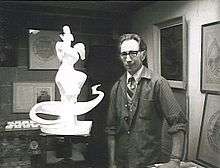Abram Belskie
| Abram Belskie | |
|---|---|
 Abram Belskie | |
| Born |
March 24, 1907 London, England |
| Died | November 7, 1988 (aged 81) |
| Occupation | Sculptor |
Abram Belskie (March 24, 1907 – November 7, 1988) was a British-born sculptor.
Biography
Belskie was born in London and grew up in Glasgow, Scotland. He graduated from the Glasgow School of Art in 1926. In 1929 he emigrated to New York, USA, to work for British sculptor John Gregory.[1]
In 1938 Belskie was introduced to physician Robert Latou Dickinson and subsequently applied his skills to create medical models, some of which were exhibited at the World's Fair of 1939. In 1942, he created two sculptures, Norma and Normman, based on data collected by Dickinson, intended to represent the statistical ideal female and male figure.[2] After Dickinson's death in 1950, Belskie instead created medallions (occasionally medicine-related).[1]
Belskie died in 1988 and, in 1993, the Belskie Museum of Arts and Science was opened in Closter, New Jersey. It was founded by the Closter Lions Club to preserve, house and exhibit the works of Abram Belskie. It was entirely funded by membership fees, donations, grants and local subsidies.[3]
Memberships
- National Sculpture Society, fellow
- National Academy of Design, fellow
- The American Numismatic Society, fellow
- Allied Artists of America.
Awards
- John Keppie Traveling Scholarship, Scotland, 1926;
- Sir John Edward Burnett Prize, Scotland, 1928;
- Lindsay Morris Memorial Award, 1951;
- J. Sanford Saltus Medal, American Numismatic Society, 1959:
- Mrs. Louis Bennett Award, 1956; Golden Anniversary Prize, Allied Artists of America, 1963
Collections
In addition to private collections, Belskie's work is exhibited at:
- American Museum of Natural History, New York [3]
- The Field Museum, Chicago, Illinois [3]
- Mariner's Museum, Newport News, Virginia
- Brookgreen Gardens, Pawley Island, South Carolina
- Cleveland Health Museum, Cleveland, OH;
- Johnson & Johnson, New Brunswick, New Jersey.
- Jewish Theological Seminary, New York
- Park Avenue Synagogue, New York
- New York Academy of Medicine, New York [3]
- The Belskie Museum, Closter, New Jersey
References
- 1 2 "Abram Belskie". The Belskie Museum of Art & Science. Retrieved December 21, 2014.
- ↑ Curnutt, Kirk. "Perfectly Average: The Pursuit of Normality in Postwar America". Journal of American History. Oxford University Press. 99 (1): 354–355. Retrieved 2016-03-13.
- 1 2 3 4 Contillo, Christine (June 19, 2005). "BY THE WAY; All Art Is Local". The New York Times. Retrieved December 21, 2014.